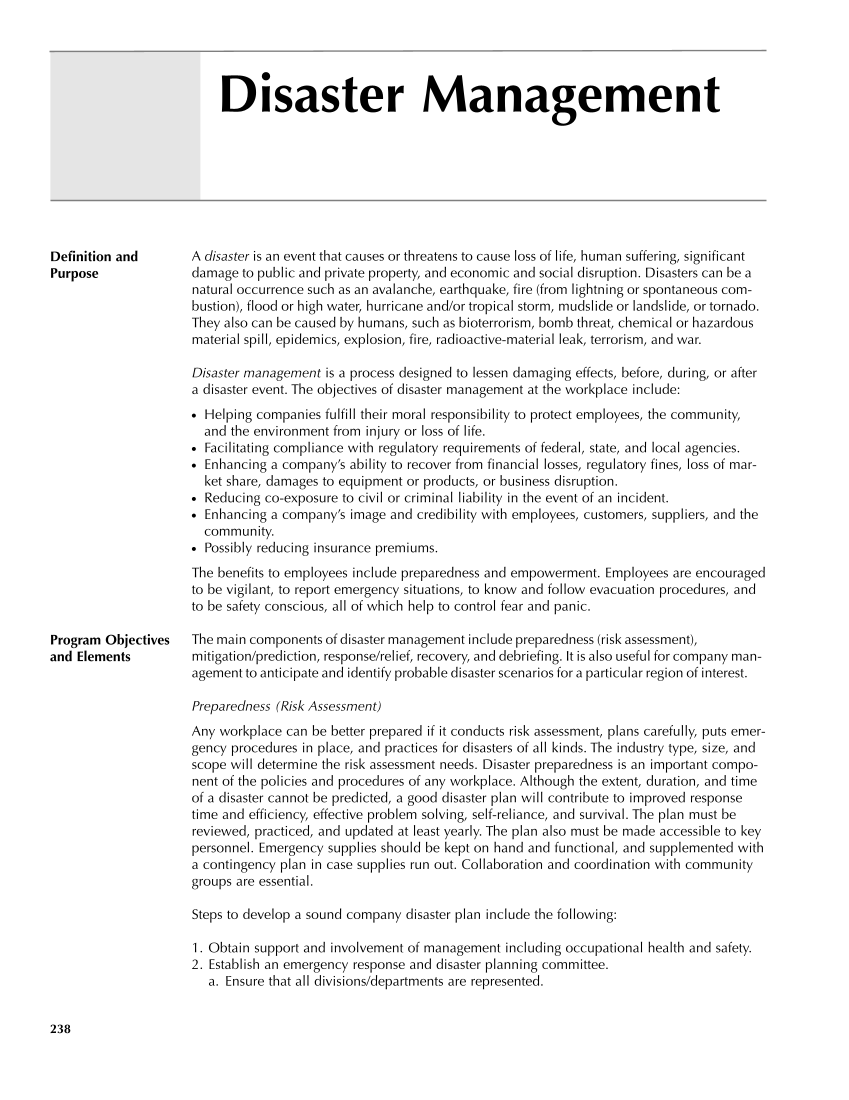A disaster is an event that causes or threatens to cause loss of life, human suffering, significant damage to public and private property, and economic and social disruption. Disasters can be a natural occurrence such as an avalanche, earthquake, fire (from lightning or spontaneous com- bustion), flood or high water, hurricane and/or tropical storm, mudslide or landslide, or tornado. They also can be caused by humans, such as bioterrorism, bomb threat, chemical or hazardous material spill, epidemics, explosion, fire, radioactive-material leak, terrorism, and war. Disaster management is a process designed to lessen damaging effects, before, during, or after a disaster event. The objectives of disaster management at the workplace include: ● Helping companies fulfill their moral responsibility to protect employees, the community, and the environment from injury or loss of life. ● Facilitating compliance with regulatory requirements of federal, state, and local agencies. ● Enhancing a company’s ability to recover from financial losses, regulatory fines, loss of mar- ket share, damages to equipment or products, or business disruption. ● Reducing co-exposure to civil or criminal liability in the event of an incident. ● Enhancing a company’s image and credibility with employees, customers, suppliers, and the community. ● Possibly reducing insurance premiums. The benefits to employees include preparedness and empowerment. Employees are encouraged to be vigilant, to report emergency situations, to know and follow evacuation procedures, and to be safety conscious, all of which help to control fear and panic. The main components of disaster management include preparedness (risk assessment), mitigation/prediction, response/relief, recovery, and debriefing. It is also useful for company man- agement to anticipate and identify probable disaster scenarios for a particular region of interest. Preparedness (Risk Assessment) Any workplace can be better prepared if it conducts risk assessment, plans carefully, puts emer- gency procedures in place, and practices for disasters of all kinds. The industry type, size, and scope will determine the risk assessment needs. Disaster preparedness is an important compo- nent of the policies and procedures of any workplace. Although the extent, duration, and time of a disaster cannot be predicted, a good disaster plan will contribute to improved response time and efficiency, effective problem solving, self-reliance, and survival. The plan must be reviewed, practiced, and updated at least yearly. The plan also must be made accessible to key personnel. Emergency supplies should be kept on hand and functional, and supplemented with a contingency plan in case supplies run out. Collaboration and coordination with community groups are essential. Steps to develop a sound company disaster plan include the following: 1. Obtain support and involvement of management including occupational health and safety. 2. Establish an emergency response and disaster planning committee. a. Ensure that all divisions/departments are represented. 238 Definition and Purpose Program Objectives and Elements Disaster Management
Purchased from OEM Press by (ge corporate access). (C) 2013 OEM Health Information, Inc. All rights reserved.












































































































































































































































































































































































































































